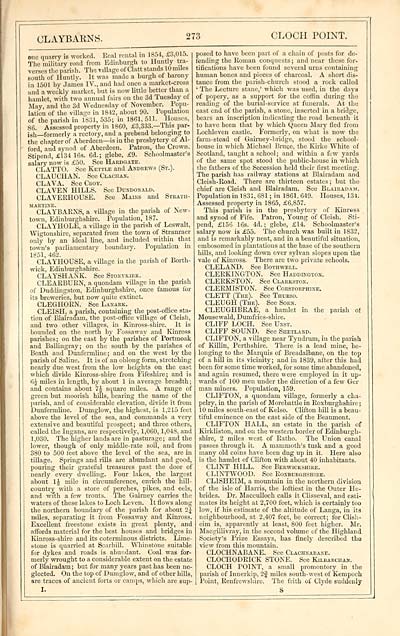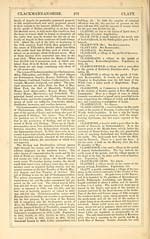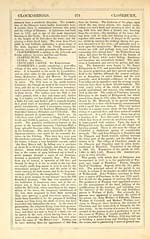Download files
Complete book:
Individual page:
Thumbnail gallery: Grid view | List view

CLAYBAKNS.
273
CLOCI-I POINT.
one quarry is worked, Bcal rental in 18o4, £3,015.
Tho military road from Edinburgh to Huntly tra-
n orses tlie parish. The Tillage of Clatt stands lOmilcs
south of Huntly. It was made a burgh of barony
in 1501 by Jamos IV., and had once a market-cross
and a weekly market, but is now litllo better than a
hamlet, with two annual fairs on the 3d Tuesday ol
May, and the 3d Wednesday of November. Popu-
lation of the village in 1842, about 90. Population
of the parish in 1831, 535; in 1861, 511. Houses,
86. Assessed property in I860, £3,333— This par-
ish—formerly a rectory, and a prebend belonging to
the chapter o"f Aberdeen— is in the presbytery of Al-
ford and synod of Aberdeen. Patron, the Crown.
Stipend, £134 16s. 6d.; glebe, £9. Schoolmaster's
salary now is £50. See Hardgate.
CLATTO. See Kettle and Andrews (St.).
CLAUCHAN. See Claciian.
CLAVA. See Cboy.
CLAVEN HILLS. Sec Dundonald.
CLAVEEHOUSE. See Mains and Stratii-
martine.
CLAYBARNS, a village in the parish of New-
town, Edinburghshire. Population, 187.
CLAYHOLE, a village in the parish of Leswalt,
Wigtonshire, separated from the town of Stranraer
only by an ideal line, and included within that
town's parliamentary boundary. Population in
1851, 462.
CLAYHOUSE, a village in the parish of Borth-
wick, Edinburghshire.
CLAYSHAXK. See Stonykirk.
CLEAEBUEN, a quondam village in the parish
of Duddingston, Edinburghshire, once famous for
its breweries, but now quite extinct.
CLEGHOEN. See Lanark.
CLEISH, a parish, containing the post-office sta-
tion of Blairadain, the post-office village of Cleish,
and two other villages, in Kinross-shire. It is
bounded on the north by Fossaway and Kinross
parishes; on the east by the parishes of Portmoak
and Ballingray ; on the south by the parishes of
Beath and Dunfermline; and on the west by the
parish of Saline. It is of an oblong form, stretching
nearly due west from the low heights on the east
which divide Kinross-shire from Fifeshire; and is
6 J miles in length, by about 1 in average breadth;
and contains about 7£ square miles. A range of
green but moorish hills, bearing the name of the
parish, and of considerable elevation, divide it from
Dunfermline. Dumglow, the highest, is 1,215 feet
above the level of the sea, and commands a very
extensive and beautiful prospect; and three others,
called the Ingans, are respectively, 1,060, 1,048, and
1,030. The higher lands are in pasturage; and the
lower, though of only middle-rate soil, and from
380 to 500 feet above the level of the sea, are in
tillage. Springs and rills are abundant and good,
pouring their grateful treasures past the door of
nearly every dwelling. Four lakes, the largest
about 1J mile in circumference, enrich the hill-
country with a store of perches, pikes, and eels,
and with a few trouts. The Gairney carries the
waters of these lakes to Loch Leven. It flows along
the northern boundary of the parish for about 2 J
miles, separating it from Fossaway and Kinross.
Excellent freestone exists in great plenty, and
affords material for the best houses and bridges in
Kinross-shire and its coterminous districts. Lime-
stone is quarried at Searhill. Whinstone suitable
for dykes and roads is abundant. Coal was for-
merly wrought to a considerable extent on the estate
of Blaii'adam ; but for many years past has been ne-
glected. On the top of Dumglow, and of other hills,
are traces of ancient forts or camps, which are sup-
I.
posed to have been part of a chain of posts for do-
fending the Eoman conquests ; and near these for.
tifications have been found several urns containing
human bones and pieces of charcoal. A short dis-
tance from the parish- church stood a rock called
' The Lecture stane,' which was used, in the days
of popery, as a support for the coffin during the
reading of the burial-service at funerals. At the
east end of the parish, a stone, inserted in a bridge,
bears an inscription indicating the road beneath it
to have been that by which Queen Mary fled from
Lochleven castle. Formerly, on what is now the
farm-stead of Gaimey-bridge, stood the school-
house in which Michael Bruce, the Kirke White of
Scotland, taught a school; and within a few yards
of the same spot stood the public-bouse in which
the fathers of the Secession held their first meeting.
The parish has railway stations at Blairadam and
Cleish-Eoad. There are thirteen estates ; but the
chief are Cleish and Blairadam. See Blairadam.
Population in 1831, 681 ; in 1861, 649. Houses, 134.
Assessed property in 1865, £6,857.
This parish is in the presbytery of Kinross
and synod of Fife. Patron, Young of Cleish. Sti-
pend, £156 16s. 4d. ; glebe, £14. Schoolmaster's
salary now is £55. The church was built in 1832,
and is remarkably neat, and in a beautiful situation,
embosomed in plantations at the base of the southern
hills, and looking down over sylvan slopes upon the
vale of Kinross. There are two private schools.
CLELAND. See Bothwell.
CLEEKINGTON. See Habdington.
CLEEKSTON. See Clarkston.
CLEEMISTON. See Corstoephine.
CLETT (The). See Thurso.
CLEUGH (The). See Sorn.
■CLEUGHBEAE, a hamlet in the parish of
Mousewald, Dumfries-shire.
CLIFF LOCH. See Unst.
CLIFF SOUND. See Shetland.
CLIFTON, a village near Tyndram, in the parish
of Killin, Perthshire. There is a lead mine, he-
longing to the Marquis of Breadalbane, on the top
of a hill in its vicinity; and in 1839, after this had
been for some time worked, for some time abandoned,
and again resumed, there were employed in it up-
wards of 100 men under the direction of a few Ger
man miners. Population, 159.
CLIFTON, a quondam village, formerly a cha-
pelry, in the parish of Morebattle in Eoxburghshire ;
10 miles south-east of Kelso. Clifton bill is a beau-
tiful eminence on the east side of the Beaumont.
CLIFTON HALL, an estate in the parish of
Kirkliston, and on the western border of Edinburgh-
shire, 2 miles west of Eatho. The Union canal
passes through it. A mammoth's tusk and a good
many old coins have been dug up in it. Here also
is the hamlet of Clifton with about 40 inhabitants.
CLINT HILL. See Berwickshire.
CLINTWOOD. See Eoxburghshire.
CL1SHEIM, a mountain in the northern division
of the isle of Harris, the loftiest in the Outer He-
brides. Dr. Macculloch calls it Clisseval, and esti-
mates its height at 2,700 feet, which is certainly too
low, if his estimate of the altitude of Langa, in its
neighbourhood, at 2,407 feet, be correct; for dish-
em! is, apparently at least, 800 feet higher. Mr.
Macgillivray, in the second volume of the Highland
Society's Prize Essays, has finely described the
view from this mountain.
CLOCHNABANE. See Clachnabane.
CLOCHODEICK STONE. See Kilbaechan.
CLOCH POINT, a small promontory in the
parish of Innerkip, 2f miles south-west of Kempoch
Point, Renfrewshire. The frith of Clyde suddenly
273
CLOCI-I POINT.
one quarry is worked, Bcal rental in 18o4, £3,015.
Tho military road from Edinburgh to Huntly tra-
n orses tlie parish. The Tillage of Clatt stands lOmilcs
south of Huntly. It was made a burgh of barony
in 1501 by Jamos IV., and had once a market-cross
and a weekly market, but is now litllo better than a
hamlet, with two annual fairs on the 3d Tuesday ol
May, and the 3d Wednesday of November. Popu-
lation of the village in 1842, about 90. Population
of the parish in 1831, 535; in 1861, 511. Houses,
86. Assessed property in I860, £3,333— This par-
ish—formerly a rectory, and a prebend belonging to
the chapter o"f Aberdeen— is in the presbytery of Al-
ford and synod of Aberdeen. Patron, the Crown.
Stipend, £134 16s. 6d.; glebe, £9. Schoolmaster's
salary now is £50. See Hardgate.
CLATTO. See Kettle and Andrews (St.).
CLAUCHAN. See Claciian.
CLAVA. See Cboy.
CLAVEN HILLS. Sec Dundonald.
CLAVEEHOUSE. See Mains and Stratii-
martine.
CLAYBARNS, a village in the parish of New-
town, Edinburghshire. Population, 187.
CLAYHOLE, a village in the parish of Leswalt,
Wigtonshire, separated from the town of Stranraer
only by an ideal line, and included within that
town's parliamentary boundary. Population in
1851, 462.
CLAYHOUSE, a village in the parish of Borth-
wick, Edinburghshire.
CLAYSHAXK. See Stonykirk.
CLEAEBUEN, a quondam village in the parish
of Duddingston, Edinburghshire, once famous for
its breweries, but now quite extinct.
CLEGHOEN. See Lanark.
CLEISH, a parish, containing the post-office sta-
tion of Blairadain, the post-office village of Cleish,
and two other villages, in Kinross-shire. It is
bounded on the north by Fossaway and Kinross
parishes; on the east by the parishes of Portmoak
and Ballingray ; on the south by the parishes of
Beath and Dunfermline; and on the west by the
parish of Saline. It is of an oblong form, stretching
nearly due west from the low heights on the east
which divide Kinross-shire from Fifeshire; and is
6 J miles in length, by about 1 in average breadth;
and contains about 7£ square miles. A range of
green but moorish hills, bearing the name of the
parish, and of considerable elevation, divide it from
Dunfermline. Dumglow, the highest, is 1,215 feet
above the level of the sea, and commands a very
extensive and beautiful prospect; and three others,
called the Ingans, are respectively, 1,060, 1,048, and
1,030. The higher lands are in pasturage; and the
lower, though of only middle-rate soil, and from
380 to 500 feet above the level of the sea, are in
tillage. Springs and rills are abundant and good,
pouring their grateful treasures past the door of
nearly every dwelling. Four lakes, the largest
about 1J mile in circumference, enrich the hill-
country with a store of perches, pikes, and eels,
and with a few trouts. The Gairney carries the
waters of these lakes to Loch Leven. It flows along
the northern boundary of the parish for about 2 J
miles, separating it from Fossaway and Kinross.
Excellent freestone exists in great plenty, and
affords material for the best houses and bridges in
Kinross-shire and its coterminous districts. Lime-
stone is quarried at Searhill. Whinstone suitable
for dykes and roads is abundant. Coal was for-
merly wrought to a considerable extent on the estate
of Blaii'adam ; but for many years past has been ne-
glected. On the top of Dumglow, and of other hills,
are traces of ancient forts or camps, which are sup-
I.
posed to have been part of a chain of posts for do-
fending the Eoman conquests ; and near these for.
tifications have been found several urns containing
human bones and pieces of charcoal. A short dis-
tance from the parish- church stood a rock called
' The Lecture stane,' which was used, in the days
of popery, as a support for the coffin during the
reading of the burial-service at funerals. At the
east end of the parish, a stone, inserted in a bridge,
bears an inscription indicating the road beneath it
to have been that by which Queen Mary fled from
Lochleven castle. Formerly, on what is now the
farm-stead of Gaimey-bridge, stood the school-
house in which Michael Bruce, the Kirke White of
Scotland, taught a school; and within a few yards
of the same spot stood the public-bouse in which
the fathers of the Secession held their first meeting.
The parish has railway stations at Blairadam and
Cleish-Eoad. There are thirteen estates ; but the
chief are Cleish and Blairadam. See Blairadam.
Population in 1831, 681 ; in 1861, 649. Houses, 134.
Assessed property in 1865, £6,857.
This parish is in the presbytery of Kinross
and synod of Fife. Patron, Young of Cleish. Sti-
pend, £156 16s. 4d. ; glebe, £14. Schoolmaster's
salary now is £55. The church was built in 1832,
and is remarkably neat, and in a beautiful situation,
embosomed in plantations at the base of the southern
hills, and looking down over sylvan slopes upon the
vale of Kinross. There are two private schools.
CLELAND. See Bothwell.
CLEEKINGTON. See Habdington.
CLEEKSTON. See Clarkston.
CLEEMISTON. See Corstoephine.
CLETT (The). See Thurso.
CLEUGH (The). See Sorn.
■CLEUGHBEAE, a hamlet in the parish of
Mousewald, Dumfries-shire.
CLIFF LOCH. See Unst.
CLIFF SOUND. See Shetland.
CLIFTON, a village near Tyndram, in the parish
of Killin, Perthshire. There is a lead mine, he-
longing to the Marquis of Breadalbane, on the top
of a hill in its vicinity; and in 1839, after this had
been for some time worked, for some time abandoned,
and again resumed, there were employed in it up-
wards of 100 men under the direction of a few Ger
man miners. Population, 159.
CLIFTON, a quondam village, formerly a cha-
pelry, in the parish of Morebattle in Eoxburghshire ;
10 miles south-east of Kelso. Clifton bill is a beau-
tiful eminence on the east side of the Beaumont.
CLIFTON HALL, an estate in the parish of
Kirkliston, and on the western border of Edinburgh-
shire, 2 miles west of Eatho. The Union canal
passes through it. A mammoth's tusk and a good
many old coins have been dug up in it. Here also
is the hamlet of Clifton with about 40 inhabitants.
CLINT HILL. See Berwickshire.
CLINTWOOD. See Eoxburghshire.
CL1SHEIM, a mountain in the northern division
of the isle of Harris, the loftiest in the Outer He-
brides. Dr. Macculloch calls it Clisseval, and esti-
mates its height at 2,700 feet, which is certainly too
low, if his estimate of the altitude of Langa, in its
neighbourhood, at 2,407 feet, be correct; for dish-
em! is, apparently at least, 800 feet higher. Mr.
Macgillivray, in the second volume of the Highland
Society's Prize Essays, has finely described the
view from this mountain.
CLOCHNABANE. See Clachnabane.
CLOCHODEICK STONE. See Kilbaechan.
CLOCH POINT, a small promontory in the
parish of Innerkip, 2f miles south-west of Kempoch
Point, Renfrewshire. The frith of Clyde suddenly
Set display mode to: Large image | Transcription
Images and transcriptions on this page, including medium image downloads, may be used under the Creative Commons Attribution 4.0 International Licence unless otherwise stated. ![]()
| Gazetteers of Scotland, 1803-1901 > Imperial gazeteer of Scotland, or, Dictionary of Scottish topography > Volume 1 > (381) Page 273 |
|---|
| Permanent URL | https://digital.nls.uk/97463702 |
|---|
| Description | Volume I: Aan-Gordon. |
|---|---|
| Attribution and copyright: |
|

